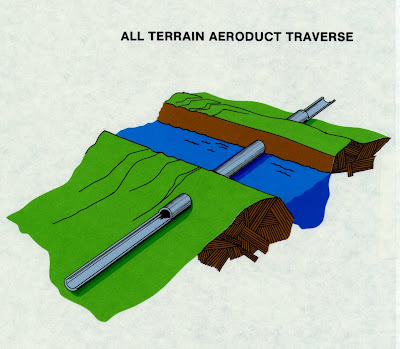The Tappan Zee Bridge is located about twenty five miles north of New York City, and is almost three miles long, including approach ramps. It was built in the early 1950s, is very heavily used, and the New York State Department of Transportation must do something about either extensively refurbishing it or replacing it. The press release indicates that remodeling it is not a viable option:
The Tappan Zee Bridge, constructed 52 years ago, was built according to prevailing standards in the early 1950s. While the bridge is safe, its design does not meet current national standards for structural elements and some of its deficiencies can not be addressed – even in the most robust rehabilitation scenarios – because of the structure’s basic design characteristics.The replacement plan (or plans, since there are several options) and cost(s) are as follows:
Full implementation of the project team’s proposal would cost: $6.4 billion for a new bridge accepting bus rapid transit and commuter rail transit; $2.9 billion for bus rapid transit and highway improvements; and $6.7 billion for the build-out of commuter rail transit in the future.The Tappan Zee Bridge proposal is notable for certain reasons:
1) It will cost a great deal of money, especially with the options for including rapid buses and a rail line. Because it spans one of the widest points of the Hudson River, it is a long bridge, requires many supports and therefore more preventive and actual maintenance.
2) The project reinforces the idea of transportation corridors. For cars or trucks to traverse the Hudson, they must all converge on the area of the bridge. There is no bridge within twenty miles north or south of this one. The mass transit additions of lanes for rapid buses and commuter trains further accentuates the bridge as being an important transportation artery; in other words, confining transportation to a corridor.
Considering the great cost of any new bridge, the focus on making this one even more of a transportation artery by adding mass transit capacity isn't surprising. On the one hand, we can look at this as confining travel to across the Hudson to just one structure for over 50 miles. But, to broaden the transportation corridor by building another bridge perhaps 10 miles to the south or to the north would not only require great expenditures of money on this other bridge, but would require new roads to take people to the bridge, adding even more expense.
Every place where transportation requires bridges endures bottlenecks and safety issues beyond those of just roads. Bridge costs for creation and maintenance are very high. As I've said in earlier posts, bridges are hammered day and night by heavy cars and even heavier trucks. And, adding special lanes for fast buses or trains will increase the load on the bridge, requiring more support, more maintenance and more expense. Certainly the mass transit additions to the bridge decrease dependence on cars, but they still add to the pounding the bridge must endure.
Our Aeroduct System will also need to cross rivers, but will require much less support and will endure far, far less pounding from the vehicles in the system. The pressure exerted by air cushion vehicles on their guideways (or "roads") is very light. An Aeroduct bridge would require some supports for longer spans, like that bridged at Tappan Zee, but these supports would be fewer and more lightweight. So, more crossings of the Hudson or other bodies of water could be built, all for much less money, putting an end to clogged transportation arteries. And, the guideways can be stacked horizontally or vertically, allowing far more throughput than current bridges.
It should be clear that any attempts to "upgrade" existing infrastructure for wheel based infrastructure will be hugely expensive and do little to decrease the congestion and high maintenance made necessary by the nature of that infrastructure. The Aeroduct System will cost money to implement, but it has far more potential than the roads and bridges of today, and will be vastly cheaper to build or maintain, will be safer, weather immune, faster and extensible. Faced with what will be a trillion dollar budget to just keep our existing roads and bridges from falling apart, and that is without adding any new capacity, shouldn't we be looking for an alternative?
Here is a color sketch of an Aeroduct "tube" crossing a river. As you can see, it uses open guideways leading up to the bridge, and then a closed tube across the water. A complete tube has inherent built in support, ideal for a span. If the river were wider than shown below, supports anchored on the river bed would also be needed.
From my perspective, we can continue to spend all sorts of money on keeping alive a transportation system that has many drawbacks, or we can spend our money building an entirely new system with many advantages. To find out more, here are links the Aeroduct System website and to other blog entries.


No comments:
Post a Comment